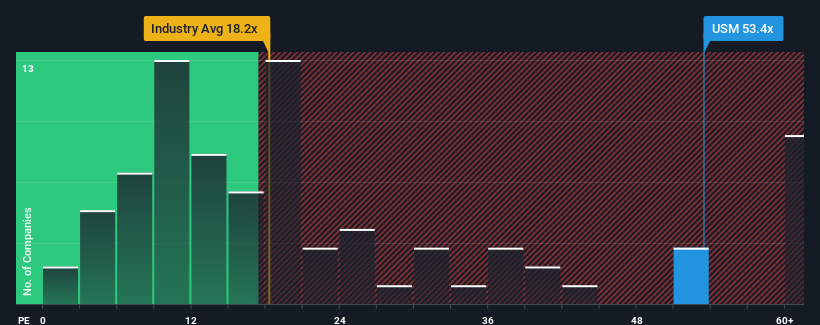- United States
- /
- Wireless Telecom
- /
- NYSE:AD
United States Cellular Corporation's (NYSE:USM) Earnings Haven't Escaped The Attention Of Investors
When close to half the companies in the United States have price-to-earnings ratios (or "P/E's") below 16x, you may consider United States Cellular Corporation (NYSE:USM) as a stock to avoid entirely with its 53.4x P/E ratio. Although, it's not wise to just take the P/E at face value as there may be an explanation why it's so lofty.
United States Cellular certainly has been doing a good job lately as its earnings growth has been positive while most other companies have been seeing their earnings go backwards. The P/E is probably high because investors think the company will continue to navigate the broader market headwinds better than most. If not, then existing shareholders might be a little nervous about the viability of the share price.
See our latest analysis for United States Cellular

What Are Growth Metrics Telling Us About The High P/E?
In order to justify its P/E ratio, United States Cellular would need to produce outstanding growth well in excess of the market.
Taking a look back first, we see that the company grew earnings per share by an impressive 80% last year. Still, incredibly EPS has fallen 76% in total from three years ago, which is quite disappointing. Accordingly, shareholders would have felt downbeat about the medium-term rates of earnings growth.
Shifting to the future, estimates from the eight analysts covering the company suggest earnings should grow by 36% each year over the next three years. That's shaping up to be materially higher than the 10% each year growth forecast for the broader market.
With this information, we can see why United States Cellular is trading at such a high P/E compared to the market. Apparently shareholders aren't keen to offload something that is potentially eyeing a more prosperous future.
The Key Takeaway
Using the price-to-earnings ratio alone to determine if you should sell your stock isn't sensible, however it can be a practical guide to the company's future prospects.
As we suspected, our examination of United States Cellular's analyst forecasts revealed that its superior earnings outlook is contributing to its high P/E. Right now shareholders are comfortable with the P/E as they are quite confident future earnings aren't under threat. Unless these conditions change, they will continue to provide strong support to the share price.
It's always necessary to consider the ever-present spectre of investment risk. We've identified 1 warning sign with United States Cellular, and understanding should be part of your investment process.
You might be able to find a better investment than United States Cellular. If you want a selection of possible candidates, check out this free list of interesting companies that trade on a low P/E (but have proven they can grow earnings).
New: Manage All Your Stock Portfolios in One Place
We've created the ultimate portfolio companion for stock investors, and it's free.
• Connect an unlimited number of Portfolios and see your total in one currency
• Be alerted to new Warning Signs or Risks via email or mobile
• Track the Fair Value of your stocks
Have feedback on this article? Concerned about the content? Get in touch with us directly. Alternatively, email editorial-team (at) simplywallst.com.
This article by Simply Wall St is general in nature. We provide commentary based on historical data and analyst forecasts only using an unbiased methodology and our articles are not intended to be financial advice. It does not constitute a recommendation to buy or sell any stock, and does not take account of your objectives, or your financial situation. We aim to bring you long-term focused analysis driven by fundamental data. Note that our analysis may not factor in the latest price-sensitive company announcements or qualitative material. Simply Wall St has no position in any stocks mentioned.
About NYSE:AD
Array Digital Infrastructure
Provides wireless telecommunications services in the United States.
Reasonable growth potential and slightly overvalued.
Similar Companies
Market Insights
Community Narratives



